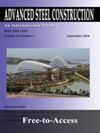外约束单轴荷载双层钢管混凝土柱简化设计模型
IF 1.7
3区 工程技术
Q3 CONSTRUCTION & BUILDING TECHNOLOGY
引用次数: 3
摘要
使用双层钢管混凝土柱的一个重要贡献是,它可以通过向混凝土内注入更均匀和连续的围压来提高柱的延性,从而延长混凝土在建筑工业中实际使用的最大强度极限。但由于初期界面粘结不完善,导致弹性强度和弹性刚度降低,无法充分发挥钢管的约束作用。为了改善这种情况,作者提出在钢管外侧采用钢环形式的外约束来限制钢管混凝土柱的膨胀,从而恢复完整的界面粘结状态。通过单轴压缩试验,验证了复合材料的弹性强度、刚度和界面粘结性均有提高。在试验结果的基础上,建立了双层钢管混凝土柱单轴承载力预测的理论模型。作为一项持续的研究,作者将研究影响单轴强度的最关键参数,并通过广泛的参数研究开发一个简化的双皮CFST柱的实际设计公式。本文章由计算机程序翻译,如有差异,请以英文原文为准。
Simplified Design Model for Uni-Axially Loaded Double-Skinned Concrete-Filled-Steel-Tubular Columns with External Confinement
One of the significant contributions of using double-skinned concrete-filled-steel-tubular (CFST) columns is that it can extend the maximum limit of concrete strength that can be practically used in the construction industry, by improving the ductility of columns through providing more uniform and continuous confining pressure to the in-filled concrete. However, because of the imperfect interface bonding occurs at early stage, the elastic strength and stiffness will decrease so that the confinement effect provided by the steel tube is not fully utilized. To improve the situation, the authors have proposed to use external confinement in the form of steel rings on the outer steel tube to restrict the dilation of CFST columns and thus restore an intact interface bonding condition. It has been verified by uni-axial compression test that the elastic strength, stiffness and interface bonding were improved. Based on the test results, the authors have developed a theoretical model for predicting the uni-axial load-carrying capacity of doubled-skinned CFST columns. As a continued study, the authors will investigate the most critical parameters affecting the uni-axial strength, and to develop a simplified formula for practical design of doubled-skinned CFST columns through an extensive parametric study.
求助全文
通过发布文献求助,成功后即可免费获取论文全文。
去求助
来源期刊

Advanced Steel Construction
CONSTRUCTION & BUILDING TECHNOLOGY-ENGINEERING, CIVIL
CiteScore
2.60
自引率
29.40%
发文量
0
审稿时长
6 months
期刊介绍:
The International Journal of Advanced Steel Construction provides a platform for the publication and rapid dissemination of original and up-to-date research and technological developments in steel construction, design and analysis. Scope of research papers published in this journal includes but is not limited to theoretical and experimental research on elements, assemblages, systems, material, design philosophy and codification, standards, fabrication, projects of innovative nature and computer techniques. The journal is specifically tailored to channel the exchange of technological know-how between researchers and practitioners. Contributions from all aspects related to the recent developments of advanced steel construction are welcome.
 求助内容:
求助内容: 应助结果提醒方式:
应助结果提醒方式:


